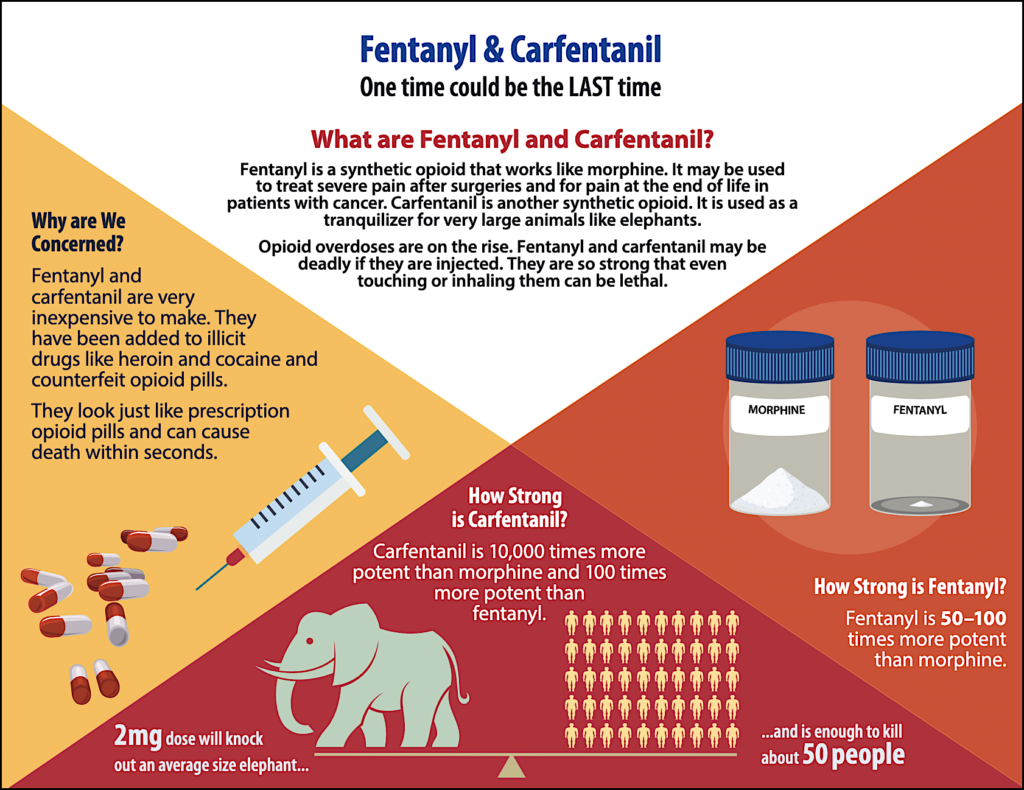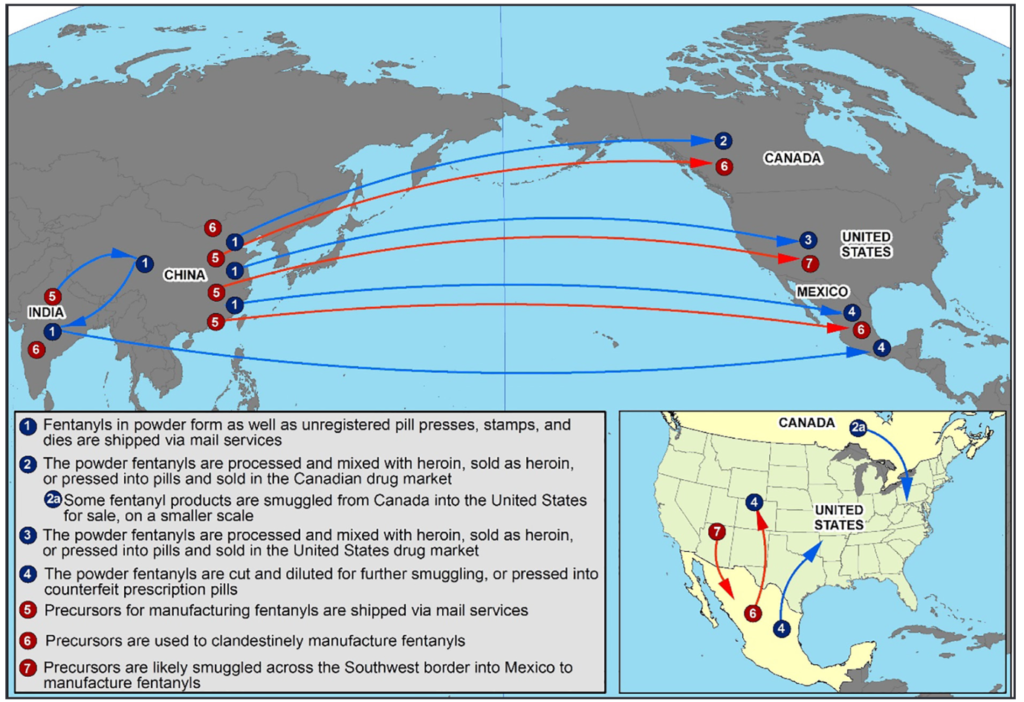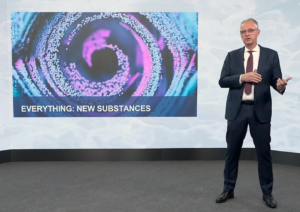A lethal dose of fentanyl © DEA
It’s been described as being 50 to 80 times stronger than morphine. You will not be surprised to learn that Fentanyl (it has several alternative names) is quickly becoming the narcotic of choice for those seeking a big hit quickly. Its molecular structure is C22H28N2 O and for the police forces of the United States, that spells trouble. What’s more, it’s already arriving in Europe and it has the police over here feeling nervous. It’s not just fentanyl: there are quite a few derivatives, such as alfentanil, sufentanil, Remifentanil and carfentanil, but by the time you’re reading this there will almost certainly be several more. The stuff is fast proliferating. After all, anything that strong is bound to prove popular and that means more money for the dealers. Who among them is going to resist that? The various derivatives were developed for the legitimate pharmaceutical industry, mainly by modifying its potency by tinkering with its substituents (and in case that word puzzles you as it did me, this is how Wikipedia explains it: “In organic chemistry, a substituent is one or a group of atoms that replaces atoms, thereby becoming a moiety in the resultant molecule.”)
In any case, the resulting narcotic is very much on the rise in Europe and the European Commissioner for Home Affairs, Ylva Johansson, has issued a warning about it. She told the media that an increasing number of new narcotics are reaching Europe and that there is a risk of poisonings and deaths because of their high potency. According to the European Monitoring Centre for Drugs and Drug Addiction (EMCDDA), “An analysis of the supply-related indicators available on all the commonly used illicit drugs in the European Union suggests that availability remains high across all substance types.” That is from the annual report for 2023, which also lists the range of narcotics currently available in Europe. It’s a worryingly long list and it’s not getting any shorter. The United States is already seeing the consequences of the spread of fentanyl and its derivatives.

Ms. Johansson told a meeting of the EMCDDA they must ensure that “America’s present does not become Europe’s future.” “A few weeks ago in Antwerp,” she told her audience , “I met with Anne Milgram, the administrator of the DEA (Drugs Enforcement Agency).” The story she had to tell, it seems, is not a cheery one. “She told me that last year in the United States, 107,000 died after taking synthetic drugs – 70% of those by taking fentanyl.” What’s more, she said the drug, along with other synthetic opioids, “is easy to make and does not need to be smuggled across continents.” She also told Johansson that small quantities are enough for thousands of doses, (and) can be easily transported. “They are extremely potent,” she said, describing them as “dangerous and deadly.” Alexis Goosdeel, the Director of the EMCDDA, warned that: “Drugs are everywhere today in Europe, there were never so many drugs and substances available in such a high purity or potency and also at stable low prices.” Her words almost read like an advertising campaign, although they’re far from being that, of course. The EMCDDA report shows growing concern over the “scale and complexity” of Europe’s illicit drugs output, with users being exposed to an ever-wider range of psychoactive substances from which to choose. Regular users of illicit narcotics must be rubbing their hands with glee. Inevitably, health issues have been raised. The EMCDDA believes more services are needed to police the problem and that there should be more “harm reduction practices” in use.
If you want to see what the social effects of fentanyl look like, you should pay a visit to San Francisco’s Tenderloin area, a place famed for homelessness, crime and drug abuse. I have not been there personally, but it’s reported that you will find fentanyl users out in the streets, lying on park benches and grassy banks and sidewalks. This may be a slight media exaggeration, but between January and March 2023 it’s believed that some 159 deaths in the United States (out of a total of around 200) were caused by fentanyl, the powerful synthetic opioid that’s been killing Americans in fairly large numbers. Fentanyl is said to be similar to morphine in many ways but quite a lot more potent. Some experts are now saying fentanyl, which can be fatal even in tiny doses, is becoming the deadliest narcotic in American history.

It’s on track to repeat the trick in Europe if we’re not careful. Activist Darren Stallcup, who has lived in the Tenderloin area all his life and who posts videos of life there, told Euronews that he has seen so many people dying of an overdose in his neighbourhood thathe feels “absolutely traumatised”. After spending a short holiday in London recently, Stallcup said: “The most import ant thing is to make sure fentanyl doesn’t find its way into the UK or Europe.” It’s a bit late for that: the drug has already claimed victims on this side of the Atlantic. According to the EMCDDA, Europe saw an estimated 5,800 deaths from drug overdose in 2020, and that is said to be an underestimate. Some 75% of the deaths involved opioids of one sort or another but of those, fentanyl accounted for a couple of hundred of the fatalities.
| NEW AND DEADLY
Deaths from fentanyl are on the rise in Europe. So, what is it, exactly? This is the BBC’s explanation: “Fentanyl is an extremely strong painkiller, prescribed for severe chronic pain, or breakthrough pain which does not respond to regular painkillers.” I think we knew that already, but what sets it apart? Here’s the BBC again: “It is an opioid painkiller which means it works by mimicking the body’s natural painkillers, called endorphins, which block pain messages to the brain.” It all sounds very innocent, not to mention useful. But it has its dark side: “The risk of harm is higher if the wrong dose or strength is used. Typical symptoms of a fentanyl overdose include slow and difficult breathing, nausea and vomiting, dizziness and increased blood pressure.” The UK’s Advisory Council on the Misuse of Drugs (ACMD) said the government should introduce controls to tackle the “emerging threat” the painkiller poses. The ACMD said a rise in the number of deaths in the UK is being driven by fentanyl being added to heroin. Much of the drug is entering a country through ordinary mail.

Heroin, of course, is produced from poppies, and in the case of the United States, it mainly enters across the southern border with Mexico, but the new opioids are being produced in Chinese laboratories and, being so strong, are fairly easy to transport by international surface mail. The material is light and comes in small packages. Last autumn police in Columbus, Ohio, seized more than 10 kilos of fentanyl, which would have been sufficient to wipe out the entire population of the state, although one assumes that was not the dealers’ intention. As it is, every single day people there are dying because of it. Originally fuelled by prescription drugs, then by opioids, the tendency towards addiction has moved on from heroin to fentanyl. According to Science Direct: “The United States is in the midst of the worst drug-related crisis in its history. Over 52,000 Americans were killed by drug overdose in 2015, an increase of more than 300% since the turn of the century. Driven primarily by opioids that kill an average of nearly 100 Americans every day (according to Rudd, Puja, Felicita, & Scholl, 2016), the grim toll of overdose-related death and disability has reached levels of devastation unseen since the height of the AIDS epidemic. In fact, it’s being compared with the problems that arose from prohibition, a century ago.
So, prohibition strikes again. That was then and this is now, and the picture seems no rosier. Opioid dependence unfortunately cannot be dissipated by switching to ineffective replacements or by using what are called “abuse deterrent” drugs. Instead, addicts switch to black market alternatives that may be even more dangerous, including heroin itself. It has encouraged the use of drugs delivered by injection, complete with the risks of infectious diseases that entails. Something that is not to be encouraged, naturally. Al Capone may be gone but there is no shortage of crooks eager to take his place. In October 2014, American border police seized 10.7 kilos of fentanyl that were being smuggled across the border from Mexico. Move forward eight years and the amount seized by police had reached 8,400 kilos. There is clearly a big demand for the stuff. According to Reuters, fentanyl seizures by weight more than tripled in the last quarter of 2022 compared with a year earlier. 20% of the volume seized was taken from ordinary people in the street, so in part at least it would seem that smuggling is still a cottage industry.

“The global production potential for fentanyl is just astronomical,” said Bryce Pardo, a research officer at the UN Office on Drugs and Crime, “as long as precursor chemicals are available, the supply of the finished drug is ‘virtually endless’” he said. Good news of sorts for addicts and drug dealers, maybe not so good for the rest of us. A clamp-down, then, as a solution? “Interdiction is typically thought to stop just 5% to 10% of the total quantity of illicit drugs trafficked across the border, U.S. government officials say,” according to Reuters. It packs up small, too: one kilo could provide more than 50,000 doses.
Nobody would choose to phase it out completely, either.
As the UK’s National Health Service (NHS) explains: “Fentanyl is a strong opioid painkiller. It’s used to treat severe pain, for example during or after an operation or a serious injury, or pain from cancer.” Like other types of pain killer, fentanyl can cause constipation, but that would seem little more than an inconvenience after a period of prolonged pain. After all, morphine can have the same effect, as can codeine. And, as you know, Fentanyl is said to be quite a lot more powerful than heroin (there’s no agreement, it seems, on exactly how much more powerful). Meanwhile, Britain’s Advisory Council on the Misuse of Drugs (ACMD) said the government should introduce controls to tackle the “emerging threat” the painkiller poses. The ACMD said a rise in the number of deaths in the UK is being driven by fentanyl being added to heroin. There’s nothing like increasing one’s own dose when required. Not very wise, though, given the drugs potency. Typical symptoms of a fentanyl overdose include slow and difficult breathing, nausea and vomiting, dizziness and increased blood pressure. And, of course, death.
Like other analgesics, fentanyl works by blocking the pain signals between the brain and the rest of the body, and by reducing pain levels it also has the effect of lowering anxiety. It can take the form of patches that are placed on the skin, or as lozenges that dissolve in the mouth. It can even come as a nasal spray, although injections, which are generally the fastest-acting form of delivery, are only given in a hospital, as a rule. It’s very hard to know the strength of the fentanyl you plan to use, which explains why, according to the CDC, (the US Centres for Disease Control and Prevention) man-made opioids like fentanyl are fuelling the majority of overdose deaths in the United States. For most users, the drug’s extreme strength comes as a bit of a shock (possibly for some users quite a pleasant one, albeit it quite brief). The estimated fatal dose of fentanyl in the majority of humans is thought to be around a mere 2 mg, which is not far beyond the recommended dose for its use as an analgesic.

| STRONG, SILENT AND DEADLY?
According to the EMCDDA, Animal tests conducted by the Janssen Pharmaceutical research group showed that the analgesic potency of fentanyl was 470 times that of morphine, while alpha-methylfentanyl was 600 times more potent. However the cis(+) form of 3-methyl fentanyl was 6,684 times more potent and the trans(±) form approximately 500 times more potent than morphine in the same tests. Certainly a bit more than you’d want for a mild headache. Research shows that a lot of the deaths associated with fentanyl came as a result of it being used to lace a dose of heroin. They shouldn’t be used together (or at all, except with medical supervision). It seems there are even stronger versions in circulation, too. For instance, the cis(+) form of 3-methyl fentanyl (that’s how it is shown on the EMCDDA website) was 6,684 times more potent and the trans(±) form (whatever that it) approximately 500 times more potent than morphine in the same tests. Carfentanil is said to be 10,000 times more potent than morphine. Its popularity is not hard to understand, but nor is the trail of death it leaves behind it. Most of the variations that exist have no medical use whatever, apart from alfentanil (a surgical anaesthetic), sufentinyl (another surgical anaesthetic), and remifentanil (a short-acting anaesthetic for use only during surgery). If anyone ever offers you carfentanil, don’t take it; it’s for immobilising large animals prior to veterinary surgery and probably wouldn’t help you unless you’re a sick elephant. Most of the fentanyl in (illegal) circulation is made in Belgium or the United States. The White House has now asked Congress for an extra $800-million to fight addiction and overdoses, which killed more than 100,000 people in the US, according to provisional figures from the Centers for Disease Control and Prevention. The people behind the manufacture and sale of illicit narcotics are not interested in the death toll, merely in the profit to be made.
According to Dr. Rahul Gupta, the director of the White House Office of National Drug Control Policy, someone in the U.S. dies every five minutes from an overdose, “so the urgency could never be more important at this point in time,” he stressed.

Meanwhile, the presence of Xylazine, an animal tranquilizer, in fentanyl products is said to be on the increase. Yahoo News reports that the monthly percentage of deaths from illicitly manufactured fentanyl products, including xylazine spiked from 2.9% in January 2019 to 10.9% in June 2022 in 20 states and Washington, D.C., according to a study. It’s being claimed that the United States is now experiencing its worst-ever drug-related crisis. Part of that problem is still heroin, of course, but increasingly it’s fentanyl that is part of the problem. In America’s case, part of the problem is over-prescription of opioids, usually in good faith but probably unwise. The fact is that if a patient is clearly in pain and a doctor knows that a strong analgesic will help to ease it, it’s tempting for a doctor to use what’s easily to hand. Doctors are aware of the dangers, but even so more than 52,000 Americans died through drug overdoses in 2015 alone.
The main reason is that the drug is so strong, and people are not used to that. This is especially true, of course, if the drug is bought on the street or over the Internet. As the very useful website, Drugs.com, points out: “Even though an online pill identifier might show that a pill bought on the street looks like a legitimate prescription pill because it has the same colour, shape or imprint code, this is most likely NOT true. Illegal drug manufacturers create fake opioid pills to look exactly like the real ones. The fake pills may also contain fentanyl, or only contain fentanyl. You cannot tell if a pill, powder, nasal spray or injection bought off of the street contains a deadly dose of any drug just by looking at it.” I’m inclined to think that anyone buying a drug of any kind from someone hawking them on a street corner or else from an uncertain on-line source must surely expect trouble? My mother used to tell me not to put anything in my mouth if I didn’t know where it came from. It was sound advice then and it still is (despite her tendency to rely on aspirin).
Opioids were involved in 68,630 overdose deaths in the United States in 2020. That’s 74.8% of all drug overdose deaths. In 2020 there were 56,000 deaths in the US linked to synthetic opioids such as fentanyl. That’s a 56% rise when compared with 2019 and accounted for 82% of all opioid deaths. Because it’s so powerful and cheap for dealers to obtain, it has been being mixed with other drugs, such as heroin, methamphetamine, crack cocaine and other substances, creating what has proved to be a fatal cocktail. A lot of fentanyl entering the United States originates in Mexico, China and – according to the DEA – and increasingly from India. It kills some people by suppressing breathing and heart rate, although probably not if you were prescribed the drug by a medical professional who knows your case and you, and if you follow professional advice. If you are using it as a tablet, a skin patch, tongue spray or whatever you should not switch to another form of consumption. It’s dangerous stuff and patients must be aware of the risks. It’s probably true to say that any form of chemical “medicine” (drug) that can be bought from a street vendor is almost certainly unsafe and should be avoided.

| JOINING THE FAMILY
One website points out that fentanyl is not one drug, but a generic name for a family of synthetic opioids that count as “related drugs”. They’re all part of a family known as “fentanyl analogues”. They include carfentanil, but it might be best to avoid it if it’s offered to you, because, as I mentioned earlier, as it is really a tranquilizer for elephants and other large animals. Goodnight, Jumbo, sleep well. Incidentally, it’s legal if used in that context. In the United States, fentanyl has so saturated the domestic narcotics market that ““sweeping new public-health initiatives, including treatment programs and campaigns to educate everyone, from users and medical providers to teachers and police, about the drugs’ dangers,” will be needed. Unless you have a wakeful elephant to deal with. As the strangely-named “Pain News Network puts it, “there is a vast gulf between pharmaceutical fentanyl and illicitly manufactured fentanyl. The former is a tightly controlled Schedule II prescription medication, approved for use in hospitals and to treat breakthrough cancer pain. The latter is an illegal substance cooked up in illicit labs that is often added to heroin or used to make counterfeit pills, which are then sold on the street or online.” You might be best advised to emulate my old mother and stick to aspirin after all. Fentanyl has even inspired a book, called “Fentanyl Inc”, written by Ben Westhoff, which looks into the history and development of this “drug of choice” for those seeking a chemical solution to their problems. Westhoff blames the drugs explosion onto Western markets on China. “There is little doubt that China is undercutting its publicity stated goal of stopping the export of dangerous drugs for illicit use,” he writes, “That’s because the country actively encourages the export of fentanyl and fentanyl precursors—and even synthetic cannabinoids—through its tax code and high-tech subsidies.”

Fentanyl was developed in the 1960s, and for very good reasons as a surgical anaesthetic. As Westhoff notes, “Without this compound and its analogue, sufentanil, open-heart surgery would not be possible.” No-one is seriously seeking to ban it: it’s far too useful. A measure of control, though, is clearly desirable. Needless to say, large amounts of fentanyl and its analogues are being made and sold illegally. Certainly, opioid drugs had been over-subscribed in the United States, although the authorities there have, in the years since, sought to crack down on unscrupulous providers, imposing (or trying to impose) prescription limits, because it looks as if, although prescriptions were issued in good faith, mainly through a genuine attempt to control pain, large volumes of opioids were dispensed without a proper regard to patients’ actual medical need.
Europe, while facing a slightly lower risk level, is by no means immune. The European Commissioner for Home Affairs, Ylva Johansson, has issued a warning about the growing range of narcotics available in Europe, especially fentanyl. Speaking at a press conference following the release of a new EU study, which warns about the growing number of new drugs available in Europe, Johansson sounded a grim warning about the growing risk of poisonings and deaths from what she called “high potency and more novel substances”, or drugs with which we’re unfamiliar, in other words. Johansson was launching the EU’s latest report. Ms Johansson and Alexis Goosdeel, Director of the EMCDDA, warned the audience over the rise in use of fentanyl. Irish broadcaster RTÉ pointed out that potential consumers of drugs have never before been exposed to such a wide choice. Control is becoming more difficult. Goosdeel told the broadcaster that: “Drugs are everywhere today in Europe, there were never so many drugs and substances available in such a high purity or potency and also at stable or low prices.” Fentanyl, needless to say, is right at the heart of it.

As we all found out back in the 1960s, parting young people who are having fun from the chemical substances that are helping to provide it won’t be easy. Or even possible.
The problem with the sorts of things young people like most is that – by and large – they’re illegal or at least under strict control. In the case of Fentanyl they certainly need to be. I remember the 1960s: great music, terrible (but enjoyable) fashions, girls in miniskirts…but I remember it all quite well I think, so I can’t have over-indulged too much, can I? Would you pass me that elephant, please?

